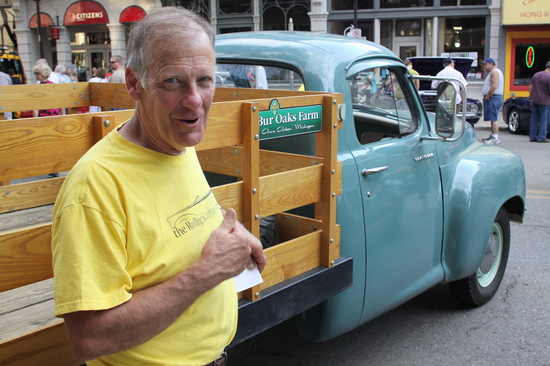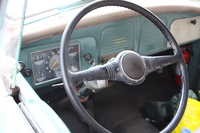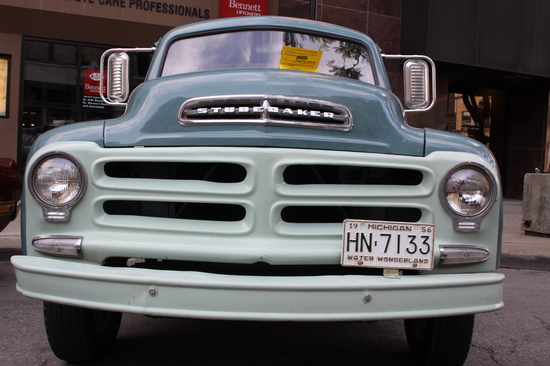For heavy-duty applications, 54-year-old Studebaker truck is in fine form

Tom Bloomer uses his Studebaker Transtar for chores around Bur Oaks Farm in Webster Township.
Ronald Ahrens | For AnnArbor.com
Tom Bloomer's 1956 Studebaker Transtar stake-body truck often prompts reactions like, "My grandfather had a Studebaker."
But Gramps probably didn’t have a Studebaker Transtar.
Bloomer has one because he thought Studebakers were good vehicles and was looking for something different. Chevrolets and Fords abounded.
“Studebaker trucks are pretty unusual,” he said. “They didn’t make a lot of them.”
Bloomer runs Bur Oaks Farm in Webster Township, growing popcorn and food-grade soybeans. The 54-year-old Transtar sees regular duty on chores.
“This truck does get used for work,” he says. “It’s not a show vehicle.”
He isn’t sure whether he acquired the truck in 1993 or 1994. Original purchase and delivery were in Iowa, and it spent most of its life there, although Bloomer found it in Illinois.
“It was pretty rough. It ran, but not well. The body was in rough shape.”
Bloomer did some restoration himself but sent the truck out for other services.
He pointed out that the wooden-stake body was available from the South Bend, Ind., factory.

Simplicity prevailed inside the Transtar's cab.
Ronald Ahrens | For AnnArbor.com
The Studebaker brothers had been in the wagon business for decades before they got into cars and trucks with electric models produced from 1902 to 1912. The first gas-engine Studebaker was a two-cylinder job in 1904, but a four followed the next year. The company’s first six-cylinder engine came in 1913. By 1920, all Studebakers were sixes.
Durability for the Studebaker Commander six was established when three models covered 25,000 miles in less than 25,000 minutes. A Studebaker Dictator took to the boards of the Atlantic City track and went 5,000 miles in less than 4,800 minutes.
The Champion six in the Transtar displaces 185 cubic inches. When it made its debut in the Champion car in 1939, the original 164-cubic-inch version produced 78 horsepower. A Champion logged 15,000 miles at Indianapolis Motor Speedway in under 15,000 minutes. Another Champion set an AAA record of 27 miles per gallon on a coast-to-coast drive.
The Transtar achieves a top speed of about 60 miles per hour, Bloomer said. The three-speed transmission with electric overdrive is operated with a gear lever mounted on the steering column.
Studebaker built a car-based pickup called the Coupe Express in the late 1930s, but the company’s biggest push into light trucks came after 1955.
Designer Raymond Loewy contributed to Studebaker’s postwar car design, but about all that can be said for the utilitarian truck is that it looks honest. It’s equipped with limited-slip differential, which was an advanced feature that allowed one of the rear driving wheels to dig in for traction if the other spun on a low-friction surface.
Truck production at the South Bend, Ind., company ended in 1964. Cars followed within a couple of years.
Bloomer said the driving experience is “noisy,” and stiff springs make the ride harsh. “It’s a completely different experience from driving a new truck.”

Function determined the Transtar's styling.
Ronald Ahrens | For AnnArbor.com


Comments
Matt
Tue, Nov 2, 2010 : 7:12 p.m.
Great truck! I had a 57 Transtar with stake side flatbed and heavy-duty lift gate. The engine was the Studebaker V8 coupled through a T-98 4 speed to a posit-traction 1 ton rear end. It didn't look as nice because of the odd looking fibergladd grille they went to in 57, but the truck was excellent. I also had a 1960 3/4 ton (Lark cab) with 1 ton running gear and locker rear end that was showroom grade - and a 57 Transtar tractor-trailer rig with 4 X 3 browning. Oddly, it had a gasoline engine. I ran all these in my organic food manufacturing and distribution business in Santa Barbara in the early 70's without a breakdown. Matt Tritt
MyView
Tue, Aug 3, 2010 : 1:36 p.m.
Bur Oaks Farm produces great food stuffs too. Tom, please add your "Chocolate Bloomers" to your product line - they were wonderful. Thanks for supplying them at the class reunion.
David Rhoads
Tue, Aug 3, 2010 : 1:14 p.m.
It is great to see these older vehicles still in use.